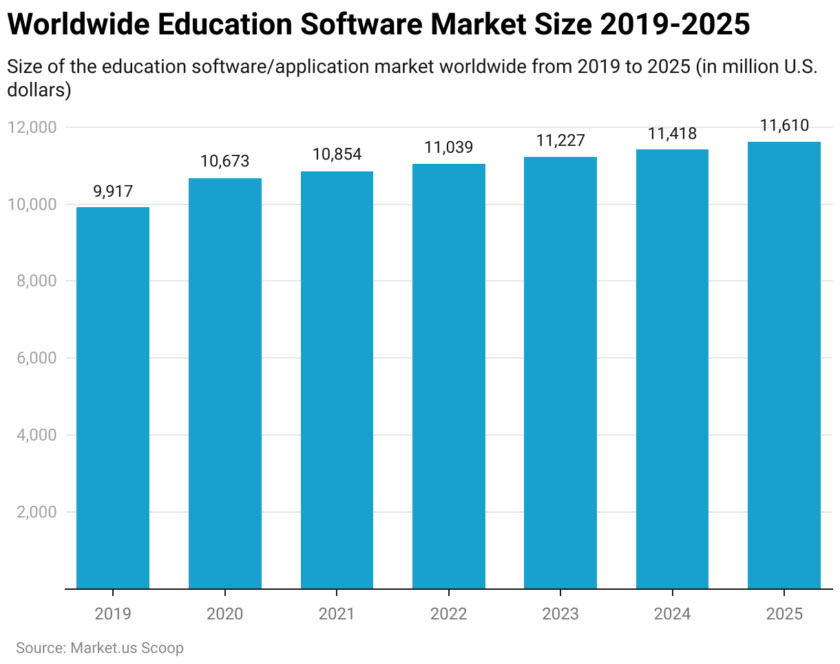In the dynamic field of technology, it’s not just about coding; students pursuing careers in this sector need a diverse array of skills and competencies to stand out and excel.
Education technology, or EdTech, leverages digital tools and technologies to enrich learning experiences and amplify educational practices. While coding has been a pronounced emphasis, the broader landscape of EdTech encompasses a wider variety of subjects and methods.
Today, the industry is propelling initiatives that stretch beyond programming skills, helping to ensure students are well-rounded and prepared for the tech-driven world.
With roughly 80% of students saying technology is essential for homework and to study for exams, better EdTech is needed, according to Jonathan Lieberman, co-founder and CEO of technology firm Itopia. He is adamant that not improving this educational field will have a negative impact on the technology industry.
One major EdTech weakness is the lack of access to the internet or computer hardware. This digital accessibility barrier poses significant challenges to online learning.
Lieberman suggested that the latest data signals the continued need for streaming and cloud technology in the classroom. Moreover, these advancements could address social issues like poor career preparedness and learning loss, presenting new avenues for the EdTech sector.
“The precise percentage of students in K-12 who struggle with access to reliable devices can vary depending on several factors, including geographic location, socioeconomic conditions, and available infrastructure,” Lieberman told TechNewsWorld.
That being said, according to a report by the National Center for Education Statistics (NCES) in the United States, during the 2019-2020 school year, approximately 14% of children ages 3-18 did not have access to a computer or tablet at home. Additionally, around 9% of children lacked access to the internet at home, he offered.
Tech Shortfalls
According to Lieberman, a 2020 report showed that one in 10 college students said their primary learning device was not equipped to perform a task required for a course during the previous week.
“These numbers indicate that a significant portion of students face challenges in accessing reliable devices and internet connectivity, which can have a notable impact on their learning,” he said.
But the failure goes beyond not just having access to the internet and a device, he continued. Even students who do have Wi-Fi and digital devices for schoolwork may not be able to fully participate in their courses if the technology they have is old, outdated, or not powerful enough to handle the demands of today’s software and streaming services.
“Streaming technology allows educational content to be accessed from anywhere with an internet connection, enabling students to learn at their own pace and on their own devices. Cloud technology provides a scalable and accessible platform for storing and delivering educational resources, reducing the need for physical infrastructure, and expanding access to educational materials,” said Lieberman about the importance of access to technology.
New Technologies Build Tech Career Interests
The EdTech space reportedly has a projected revenue forecast of $429 billion by 2030. It continues to flourish through new technologies that meet students’ needs.
Lieberman recounted that the pandemic highlighted the importance of equipping students with the skills needed for future careers. E-learning platforms, such as EdTech solutions, can offer specialized courses, vocational training, and certifications that bridge the digital skill gap by focusing on specific career paths.
Solutions like Itopia provide the infrastructure for access to applications not often accessible by slower or outdated machines. By leveraging technology, students can access these resources remotely, allowing for flexible learning and skill development, he explained.
Access to better technology helps draw graduates to the tech industry and broaden their knowledge of other career options. With the growing competition in the job market, industry certifications provide students with a competitive edge.
Lieberman noted that certifications distinguish students from their peers and give them an advantage when applying for internships, jobs, or higher education opportunities. If students cannot access software commonly used in industry certifications, they can miss out on validating their knowledge and skills, providing a sense of accomplishment, and motivating them to pursue their career goals further.
“To address this, governments and educational institutions are investing in improving broadband connectivity in schools and communities, ensuring reliable internet access for all students,” he added.
EdTech’s Economic Impact
According to Market.us Scoop, the EdTech industry is experiencing rapid growth and transforming the methods by which students acquire knowledge. Its recent report underlined the influential role EdTech is playing in the world economy, accounting for approximately 6% of the global GDP, and is a US$6.5 trillion industry while still in the early days of its digitization.
Many schools are engaging in better technology access. Consider that EdTech usage among K-12 schools has increased by 99% since 2020. More colleges expect to launch one or more online undergraduate programs in the next three years.
However, according to an extensive multinational study, EdTech is not widely integrated in many schools. Significant numbers of faculty members are either unaware or feel incapable of using it. For example:
- 36% of teachers have heard of EdTech but don’t know what it is;
- 14% of teachers have never heard about educational technology;
- 60% of academy school teachers don’t think there is enough training for EdTech;
- 75% of Northern Irish teachers report insufficient access to EdTech.
Still, the worldwide education software market has momentum, accounting for revenue of $11.03 billion in 2022 and is projected to exceed $11.61 billion by 2025.

Better technology plays a vital role in students’ study behaviors and can be key to getting students more engaged in a tech career.
Studies show that 70% of students say technology is important to study on mobile electronic devices. Another 81% of students said technology is essential for doing homework, while 79% said technology helps prepare for exams.
Non-Profit Platform Sparks Tech Career Interest
The traditional educational industry might not yet fully focus on preparing students for career training. The American Student Assistance organization has its own extracurricular solution. ASA is striving to be head of the class in erasing students’ feelings of being ill-prepared to make career choices.
According to Clay Colarusso, CMO and SVP for digital strategy of ASA, research shows that more than 65% of students feel they would have benefited from more career exploration in middle or high school. The company is changing the way kids learn about careers and navigate a path to post-secondary education and career success.
Its software platform provides young people with self-directed, digital-first experiences to help them find the right career path. That could make a significant change in career choices.
ASA research found that roughly half of high school grads wind up going to college for something they do not really want to pursue. It also revealed that 45% of Gen Z feel they lack enough information to make a career decision.
To fix those shortcomings, ASA created digital tools that enable exploration and give kids a voice in the conversations starting in middle school that will affect their futures. The software connects them to the critical resources they need to make informed, confident decisions to achieve their post-high school and career goals.
“We know from our work and research that 87% of middle schoolers were interested in ways to match their specific skills and passions with potential careers. At the same time, we understand that it might not be possible for teachers in every classroom to incorporate career exploration into the curriculum, especially during this era of pandemic-related learning loss,” Colarusso told TechNewsWorld.
Mobile-First Strategy Engages Youth
This approach works, he noted, by meeting them where they are, which is on their mobile devices. One example of a free digital resource ASA has created is Futurescape, part of ASA’s free suite of digital platforms.
Launched in 2020, this mobile-first digital experience enables users to explore real careers through a brief quiz-based self-discovery journey, with a lot of data science driving it, to connect who they are and what they love with potential careers, explained Colarusso.
“ASA believes that technology is the great equalizer in terms of reaching kids from all backgrounds, and this is the best way to engage millions more kids with their future planning,” he said.
Research shows that more than 95% of teens have or can access a cell phone. ASA’s digital direct-to-kid strategy has reached millions of young people who leverage its free suite of digital career readiness experiences, he added.
Striving To Remove Career Barriers
ASA has already engaged 12 million young people through its suite of digital resources and expects to reach 15 million by the end of 2023.
According to Colarusso, students need a voice and a defined role in developing the next generation of resources and solutions to help them navigate this education-to-career journey.
It co-creates its software content with kids who offer feedback and direction on everything, down to features and functionality, the names of the platforms, and even the color palette, fonts, and design.
“It’s one of the primary reasons these digital experiences have been so successful,” added Colarusso.
EvolveMe Into a Profession
ASA in April released its newest digital experience, EvolveMe, as part of its free suite of digital experiences designed to help kids gain awareness of education pathways and career possibilities that match their interests. The software increases access to valuable skill sets and gives them the confidence to navigate a path to success after high school.
EvolveMe prepares teens for their career journey by incentivizing them to explore, experiment, and take action via tasks. These include mentorships, virtual internships, mock job interview coaching, and coding challenges that advance career interests through transferable skills development.
ASA identifies and forms partnerships with organizations that share the goal of helping prepare middle and high school students for post-secondary education and career readiness. Colarusso added that ASA engages with millions of kids, and its partners see value in the increased awareness and access to the experience provided by integration into its platform.
So far, ASA has partnered with 23 innovative companies to provide teens with high-quality, credible career experimentation activities within the EvolveMe platform. The organization will add more partners on an ongoing basis.
“EvolveMe is an attempt to aggregate in one place as many of these digital solutions as possible through a vast network of partnerships, with an incentivization engine driving adoption and engagement across all the resources. EvolveMe is hoping to serve as a connector between great resources and the kids that need them,” Colarusso concluded.

























































